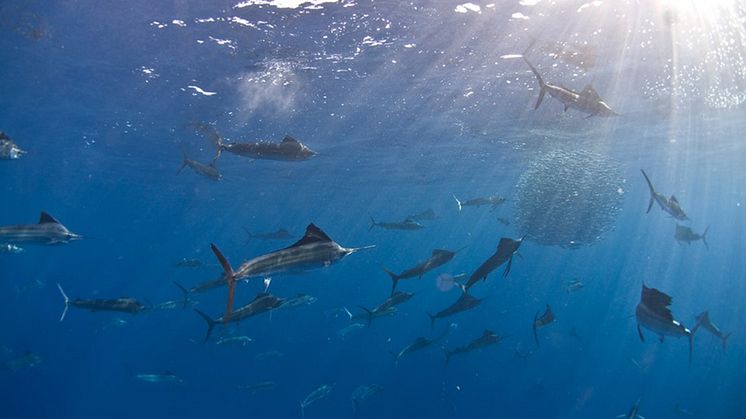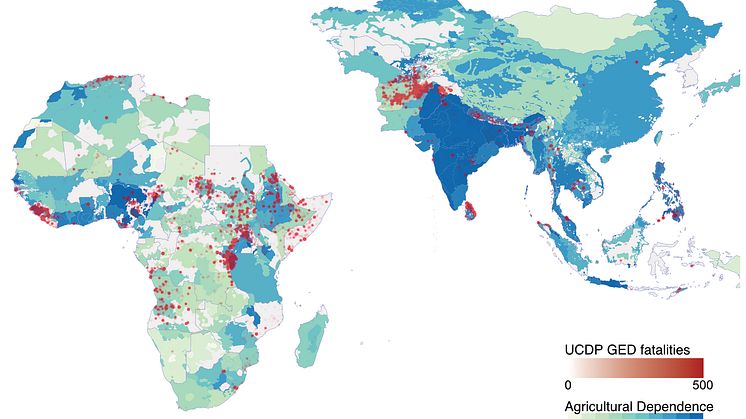Cooperation profitable for sailfish
Cooperating sailfish catch more fish per time than if they hunt individually, a new study from Uppsala University, published in the scientific journal Proceedings of the Royal Society B has shown.

Cooperating sailfish catch more fish per time than if they hunt individually, a new study from Uppsala University, published in the scientific journal Proceedings of the Royal Society B has shown.

Of the many ecological questions unfolded by climate change, the potential influence of temperature on the feeding preferences of organisms is currently gathering a great deal of attention in the scientific community. In a new study, published in the journal Ecology, researchers show that three species of tadpoles generally increased herbivory under simulated heat wave scenarios.
Since the 18th century, geologists have struggled to explain how big magma chambers form in the Earth’s crust. In particular, it has been difficult to explain where the surrounding rock goes when the magma intrudes. Now a team of researchers from Uppsala University and the Goethe University in Frankfurt have found the missing rocks – and they look nothing like what they expected.
12 specific areas of the DNA sequence are robustly related with the age at which we have our first child, and how many children we'll have during our life. That's the conclusion of a paper published in Nature Genetics today. The study is led by the University of Oxford, University of Groningen, and Uppsala University. It includes analysisis for almost 330,000 people.
Understanding how cells within tumors respond to drugs is a critical issue in anticancer drug development. In an article published in Cell Chemical Biology researchers from Uppsala University report a new approach to study cancer cells’ reactions to treatments and present how it can be used to find new promising drug combinations.
Results from a new clinical study conducted at Uppsala University suggest that curtailing sleep alters the abundance of bacterial gut species that have previously been linked to compromised human metabolic health. The new article is published in the journal Molecular Metabolism.
Where did our jaws come from? The question is more complicated than it seems, because not all jaws are the same. In a new article, published in Science, palaeontologists from China and Sweden trace our jaws back to the extinct placoderms, armoured prehistoric fish that lived over 400 million years ago.
The patient perspective is important in all medical research, and particularly in drug development. This month, a public private research initiative called PREFER, is launched to assess when and how patient preferences on benefits and risks should be incorporated in decisions on medicinal products
Severe drought is associated with a higher incidence of armed conflict among agriculture-dependent populations in the least developed states. Strengthening the political status and economic well-being of these marginalised groups, can reduce the risk of conflict. This is a key finding of a study by researchers at Uppsala University and the Peace Research Institute Oslo, published in PNAS.

In a paper published today in Nature Chemical Biology, a team of researchers from Uppsala University, the Broad Institute of MIT, Harvard, and AstraZeneca are presenting new insights into how larger-than-average molecules can be developed into pharmaceutical drugs
Remember dropping your milk teeth? In your hand was only the enamel-covered crown: the entire root of the tooth had somehow disappeared. In a paper published in Nature, a team of researchers from Uppsala University and the ESRF apply synchrotron x-ray tomography to a tiny jawbone of a 424 million year old fossil fish in order to illuminate the origin of this strange system of tooth replacement.
The following are conclusions and proposals developed during the multi-party dialogues held during Uppsala Health Summit on ending childhood obesity, 11 – 12 October 2016, in Uppsala, Sweden.